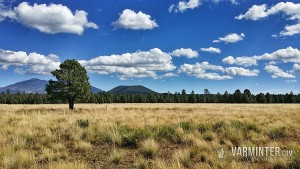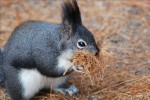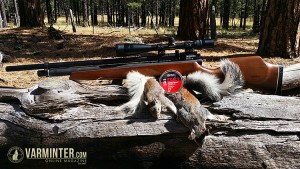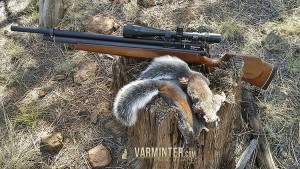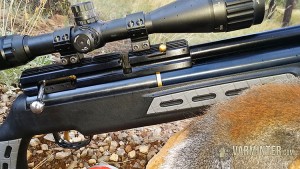When people think of Arizona, they normally think of amazing predator and big game hunting. They often miss that there lots of other hunting opportunities in the same general areas. We were in Arizona hunting prairie dogs, but when the wind started to pick-up, we headed in from the flats and made a beeline for the pine trees in the higher elevations. We went from hunting prairie dogs with powder burners, to tree squirrel hunting with airguns in Northern Arizona.
Although I haven’t done a lot of tree squirrel hunting, I did walk away from this trip with a couple of thoughts. First, tree squirrel hunting is difficult. Second, tree squirrel hunting with airguns is very difficult! I know there are a lot of tree squirrel hunters out there right now rolling their eyes, saying to themselves that it isn’t THAT hard! When you spend time in the woods committed to hunting an animal, and you learn about their habits, it does get easier. I don’t have the luxury to hunt tree squirrels very frequently, so I consider myself still a novice. Add a video camera to the mix, and makes for a difficult hunt.
Click Below to Watch the Video of the Hunts:
The Habitat and the Quarry:
Northern Arizona is a lush area, with mountains, Ponderosa Pines and grassy meadows. Within this lush area, are pockets of a unique looking tree squirrel, called the Abert’s Squirrel. They are a beautiful animal, with grayish black tufts of fur on the head, that morphs into a patch of rusty brown fur on the back, that turns gray again down to its large, furry, tail. The belly fur, and the bottom of the tail, is white, which is easy to spot while it hops through the trees. The Abert’s squirrels are around 20 inches in length (including the tail). Their conservation status is Least Concern, meaning there is a healthy population. They feed on the Ponderosa Pine seeds, inner bark, and other parts of the tree.
The Airguns:
I was shooting the Hatsan BT65 QE in .25 caliber. I had been shooting this rifle during some of my 2015 summer ground squirrel hunts, so I was familiar with the pellet ballistics and the distance where I was sure to make a clean kill. The projectiles being used in the BT65 were the JSB Exact King 25.39 grain pellets. My cameraman, Tom, was using his Benjamin Marauder shooting the JSB Jumbo Heavy 18.13 grain pellets.
The Hunt:
Most tree squirrel hunting is done by still-hunting through the forest, until you catch movement of the squirrel on the ground, or up in the trees. We did not get any shots while the squirrels were on the ground, but spotting them on the ground made it much easier to track them once went up the trees. The first area we hunted was very thick, but offered open areas so we could spot squirrels in the trees and move in for the shot. While still-hunting through the forest, we were careful to check out any noise in the trees, in case a squirrel was moving from tree to tree.
Tom was first up with the shooting, so we wandered through the trees watching for any squirrels that were moving about. We caught some movement going up one of the trees, so we got in to about 40 yards and waited for the shot to present itself. Tree squirrels are masters of disappearing in the trees they live in. So while we waited for the shot, the squirrel disappeared. We finally saw it a few minutes later, as it was tucked up in a thick area of the tree. Tom moved in for the shot, and with a huge “Thwack”, the squirrel dropped the 100′ down to the forest floor. Even Tom was a bit surprised at the shot, because his trigger pull is very light on the Marauder.
We collected the squirrel and started moving through the woods, looking for the next shot opportunity. About 10 minutes later, we came across a tree squirrel that was at the base of a tree. I immediately spotted it, and when it stopped just 30 yards away, I found it in the camera and asked Tom if he had it. Unfortunately, he didn’t see it until it started moving through the trees! Although we didn’t get the close shot, it was kind of cool seeing the squirrel leap from branch to branch, using it’s big fluffy tail to balance itself in flight and after landing. Finally, the squirrel found a thick branch where it felt safe, so it tucked into the branch, hugging it and staying perfectly still. Tom got lined-up for the shot, and took it. Although we did not hear the hit like the squirrel before, and the squirrel ran through the trees like it was fine, a few minutes later we heard branches cracking as it began the fall to the ground. Tree squirrel number two was in the bag, and we were ready to head back to the truck and clean them.
A few days later, another large storm blew through the area, so in-between the stormy weather, we headed to a spot on public land a few miles out of town. It was very windy, and light was dropping in-and-0ut when the clouds covered the sun. This made spotting, then shooting the squirrels, very difficult. After a few missed opportunities (the tree squirrels disappeared), we finally came across a squirrel that was hanging out in one tree and didn’t have another tree close enough to make an escape. I lined up for the shot with the Hatsan BT65-QE (Quiet Energy) and found him in my crosshairs. I whistled a couple of times to get the squirrel to sit-up a bit, because there was a branch in the way of the shot. My concern with hitting the branch, manifested into reality when I squeezed the trigger. In a nutshell, I hit the branch I had been so focused on trying to shoot around. Thankfully, I was offered another shot, and this time the .25 caliber pellet smacked the squirrel hard, sending it up the tree, but only for a moment. As he tried to move up the branches, the resulting damage of the shot sent him to the ground, dead. I collected this squirrel, and took some pictures with the rifle. Afterwards, I cleaned it immediately, because the rain was coming and it was time to head out of the area.
Final Thoughts:
As stated before, hunting tree squirrels with airguns is a tough hunt. Although we were able to shoot a nice group of them, it took a lot of time and patience to get the job done. Here in the west, where tree squirrels are not as thick as back east, still-hunting is a great way to hunt them. Finding an area is not difficult. Just look for shucked pine cones, and there is a good chance tree squirrels will be around. We came across a lot while driving between hunting spots, so that is an easy way to find a pocket of them as well.
After I got home, I cut the meat off the bones and fried it in some light oil. I ate it with some rice pilaf, and it was really good. It had, what I want to call a slightly pine “nutty” taste, but it tasted good, and was a great end to the hunt.
- Podcast with Soul Seekers Nation From the 2025 SHOT Show - February 17, 2025
- Complete Overview of the .17-5.56 KAK Cartridge by KAK Industry - July 21, 2024
- AGM Global Announces New and Upgraded Optics at the 2024 SHOT Show - February 1, 2024

